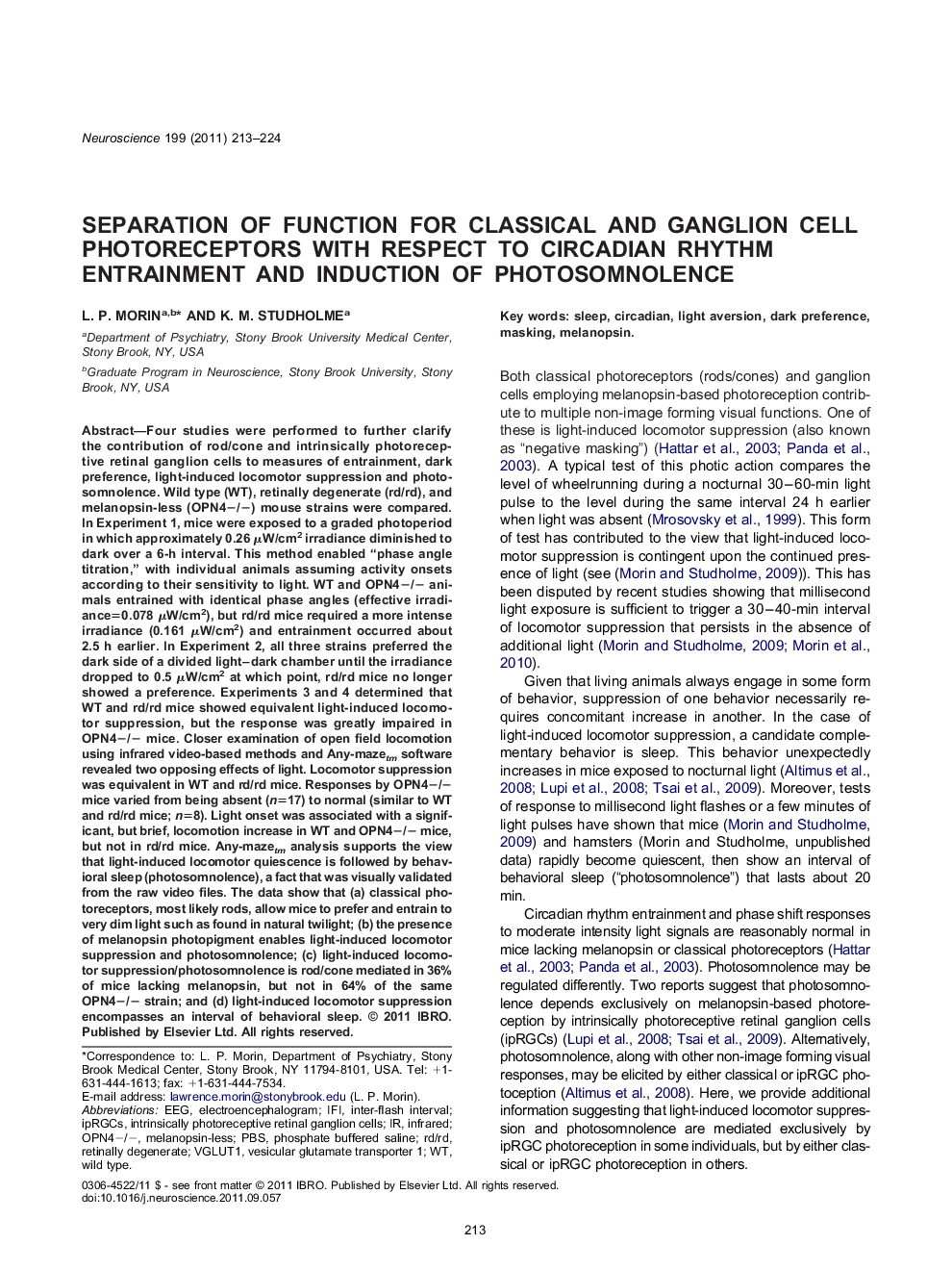| کد مقاله | کد نشریه | سال انتشار | مقاله انگلیسی | نسخه تمام متن |
|---|---|---|---|---|
| 4338671 | 1614877 | 2011 | 12 صفحه PDF | دانلود رایگان |

Four studies were performed to further clarify the contribution of rod/cone and intrinsically photoreceptive retinal ganglion cells to measures of entrainment, dark preference, light-induced locomotor suppression and photosomnolence. Wild type (WT), retinally degenerate (rd/rd), and melanopsin-less (OPN4−/−) mouse strains were compared. In Experiment 1, mice were exposed to a graded photoperiod in which approximately 0.26 μW/cm2 irradiance diminished to dark over a 6-h interval. This method enabled “phase angle titration,” with individual animals assuming activity onsets according to their sensitivity to light. WT and OPN4−/− animals entrained with identical phase angles (effective irradiance=0.078 μW/cm2), but rd/rd mice required a more intense irradiance (0.161 μW/cm2) and entrainment occurred about 2.5 h earlier. In Experiment 2, all three strains preferred the dark side of a divided light–dark chamber until the irradiance dropped to 0.5 μW/cm2 at which point, rd/rd mice no longer showed a preference. Experiments 3 and 4 determined that WT and rd/rd mice showed equivalent light-induced locomotor suppression, but the response was greatly impaired in OPN4−/− mice. Closer examination of open field locomotion using infrared video-based methods and Any-mazetm software revealed two opposing effects of light. Locomotor suppression was equivalent in WT and rd/rd mice. Responses by OPN4−/− mice varied from being absent (n=17) to normal (similar to WT and rd/rd mice; n=8). Light onset was associated with a significant, but brief, locomotion increase in WT and OPN4−/− mice, but not in rd/rd mice. Any-mazetm analysis supports the view that light-induced locomotor quiescence is followed by behavioral sleep (photosomnolence), a fact that was visually validated from the raw video files. The data show that (a) classical photoreceptors, most likely rods, allow mice to prefer and entrain to very dim light such as found in natural twilight; (b) the presence of melanopsin photopigment enables light-induced locomotor suppression and photosomnolence; (c) light-induced locomotor suppression/photosomnolence is rod/cone mediated in 36% of mice lacking melanopsin, but not in 64% of the same OPN4−/− strain; and (d) light-induced locomotor suppression encompasses an interval of behavioral sleep.
▶Entrainment and aversion to dim light utilize rod/cone, but not ipRGC photoreception. ▶Light suppression of activity is greatly disrupted in the absence of melanopsin photopigment. ▶Light acutely enhances activity by WT and OPN4−/− mice (but not rd/rd mice). ▶Light-induced “immobility” is actually light-induced sleep (“photosomnolence”). ▶Photosomnolence is normal in 1/3 of OPN4−/− mice but is absent in the remaining 2/3 of those mice.
Journal: Neuroscience - Volume 199, 29 December 2011, Pages 213–224